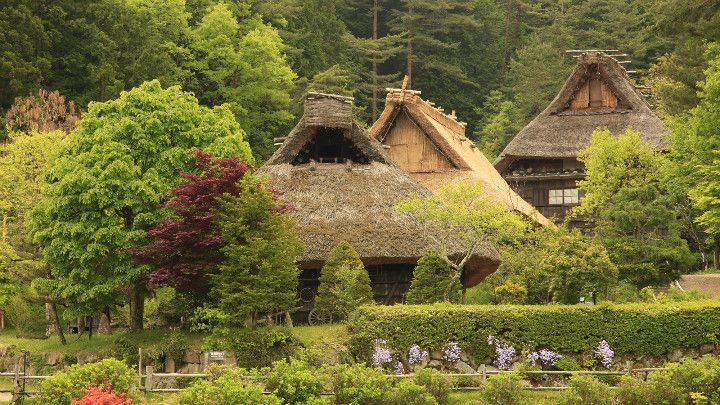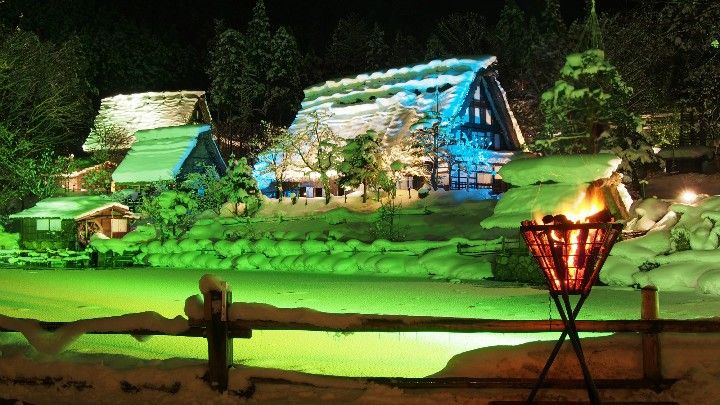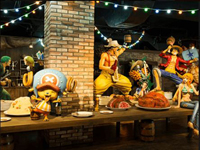Hida Minzoku Mura Folk Village : Hida no Sato


(Source: レックス9 / PIXTA(ピクスタ))
Two kinds of traditional folk houses characteristic to the area of heavy snowfall
Due to Hida being in an area of heavy snowfall, visitors can see the different countermeasures that were taken on the roofs of the houses in the village. One type is called “Gassho-zukuri,” a house with a distinctively steep rafter roof thatched with kaya grass. Another uses a Kurebuki roof, a flat roof made from high quality wooden boards, with stones pressing on the surface. Both are inventive ways to make the houses durable even under the heavy weight of snowfall.

(Source: masayosi / PIXTA(ピクスタ))
Watch and experience the culture of Hida
Houses in the village reproduce the living space as seen in old-time Japan, equipped with a room with tatami mattresses, a living room with irori (a hearth installed on the floor) and so on. In some houses, visitors can see the demonstration of the traditional needlework of Hida and may also play with toys from the old days, which is a great opportunity to learn the local traditional culture firsthand.
Illuminated Village
The village is illuminated for a limited number of days in autumn and winter. The quaint look of traditional folk houses takes on an otherworldly air. Winter, when all is covered in silvery white, is a great season to visit. Anyone would be touched by the striking visual beauty of the trinity: white snow, a traditional house and illumination.

(Source: ちょこたん / PIXTA(ピクスタ))
Hida’s seasonal events passed along over generations
At the village, many events are scheduled and participated in by the local residents throughout the year. Among them all, the village assumes a particularly vibrant air from March to early-April, as they display 850 clay dolls in various colors, in accordance with Takayama City’s celebration of its Girls’ Festival.
Omoide Taikenkan
Omoide Taikenkan (literally a “house for experiencing and creating a memory”) is located next to the bus stop of the village and offers more than 10 experience-based learning courses, such as a class teaching how to make Sarubobo, Hida’s traditional amulet dolls, or making rice crackers that double in size when baked. The finished product is all yours to take back, making it the one and only memento of your trip. No reservation is required for the courses and classes, as they are run on first-come first-serve basis.

(Source: Twitter)

(Source: レックス9 / PIXTA(ピクスタ))
Two kinds of traditional folk houses characteristic to the area of heavy snowfall
Due to Hida being in an area of heavy snowfall, visitors can see the different countermeasures that were taken on the roofs of the houses in the village. One type is called “Gassho-zukuri,” a house with a distinctively steep rafter roof thatched with kaya grass. Another uses a Kurebuki roof, a flat roof made from high quality wooden boards, with stones pressing on the surface. Both are inventive ways to make the houses durable even under the heavy weight of snowfall.

(Source: masayosi / PIXTA(ピクスタ))
Watch and experience the culture of Hida
Houses in the village reproduce the living space as seen in old-time Japan, equipped with a room with tatami mattresses, a living room with irori (a hearth installed on the floor) and so on. In some houses, visitors can see the demonstration of the traditional needlework of Hida and may also play with toys from the old days, which is a great opportunity to learn the local traditional culture firsthand.
Illuminated Village
The village is illuminated for a limited number of days in autumn and winter. The quaint look of traditional folk houses takes on an otherworldly air. Winter, when all is covered in silvery white, is a great season to visit. Anyone would be touched by the striking visual beauty of the trinity: white snow, a traditional house and illumination.

(Source: ちょこたん / PIXTA(ピクスタ))
Hida’s seasonal events passed along over generations
At the village, many events are scheduled and participated in by the local residents throughout the year. Among them all, the village assumes a particularly vibrant air from March to early-April, as they display 850 clay dolls in various colors, in accordance with Takayama City’s celebration of its Girls’ Festival.
Omoide Taikenkan
Omoide Taikenkan (literally a “house for experiencing and creating a memory”) is located next to the bus stop of the village and offers more than 10 experience-based learning courses, such as a class teaching how to make Sarubobo, Hida’s traditional amulet dolls, or making rice crackers that double in size when baked. The finished product is all yours to take back, making it the one and only memento of your trip. No reservation is required for the courses and classes, as they are run on first-come first-serve basis.

(Source: Twitter)






